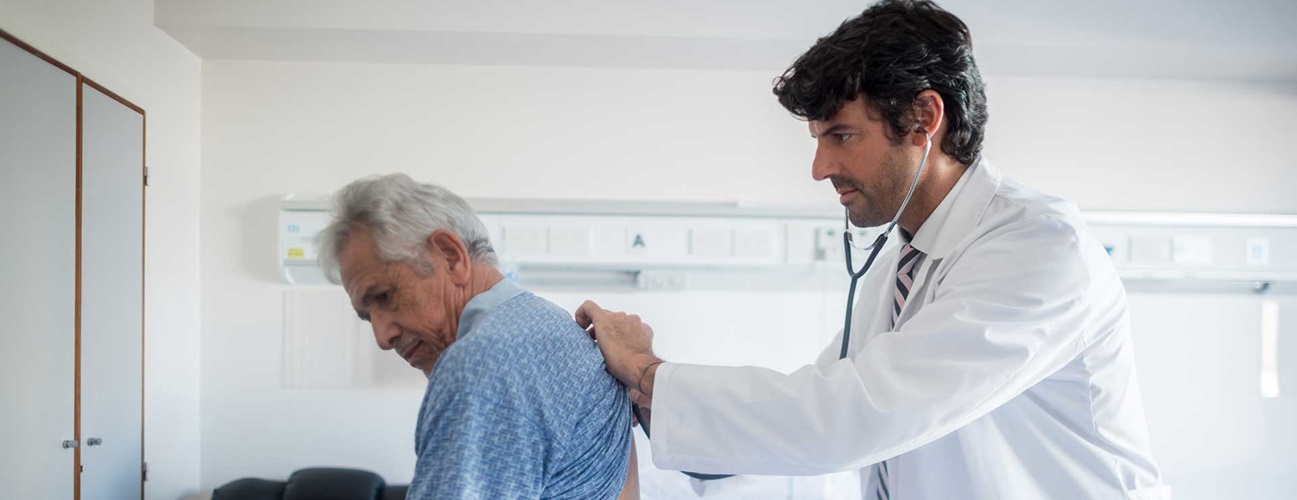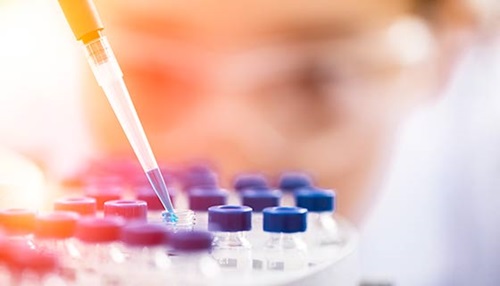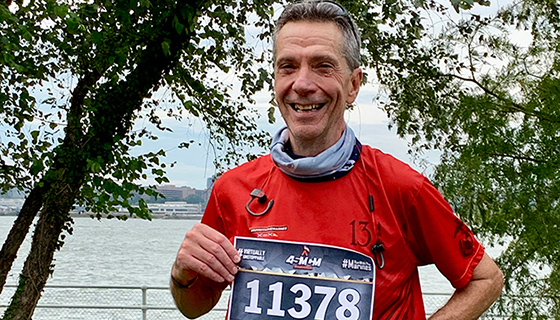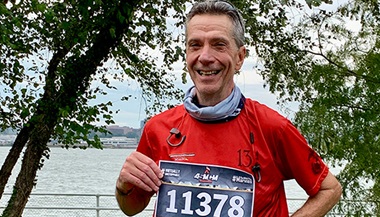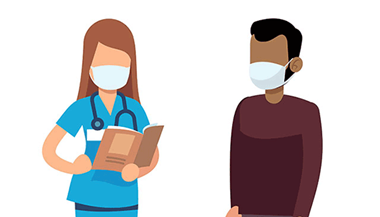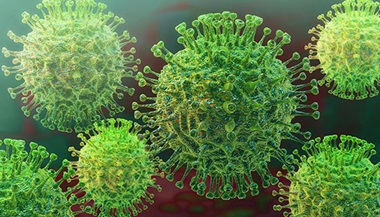COVID-19 Lung Damage
Featured Expert:
Like other respiratory illnesses, COVID-19 can cause lasting lung damage.
Panagis Galiatsatos, M.D., M.H.S., is an expert on lung disease at Johns Hopkins Bayview Medical Center and sees patients with COVID-19. He explains some of the short- and long-term lung problems brought on by the new coronavirus.
“As we continue to learn about COVID-19, we’re understanding more regarding how it affects the lungs during acute illness and afterward. And this is especially true with the virus’ ongoing variants, as well,” Galiatsatos says.
What does COVID do to lungs?
COVID-19 can cause lung complications such as pneumonia and, in the most severe cases, acute respiratory distress syndrome, or ARDS. Sepsis, another possible complication of COVID-19, can also cause lasting harm to the lungs and other organs. Newer coronavirus variants may also cause more airway disease, such as bronchitis, that may be severe enough to warrant hospitalization.
“As we have learned more about SARS-CoV-2 and resulting COVID-19, we have discovered that in severe COVID-19, a significant pro-inflammatory condition can result in several critical diseases, complications and syndromes,” Galiatsatos says.
COVID-19 Pneumonia
In pneumonia, the lungs become filled with fluid and inflamed, leading to breathing difficulties. For some people, breathing problems can become severe enough to require treatment at the hospital with oxygen or even a ventilator.
The pneumonia that COVID-19 causes tends to take hold in both lungs. Air sacs in the lungs fill with fluid, limiting their ability to take in oxygen and causing shortness of breath, cough and other symptoms.
While most people recover from pneumonia without any lasting lung damage, the pneumonia associated with COVID-19 can be severe. Even after the disease has passed, lung injury may result in breathing difficulties that might take months to improve.
COVID Bronchitis
“In COVID-19-related bronchitis, this is an issue of an excessive amount of sputum produced in the airways, resulting in coughing and chest congestion. The sputum also narrows the airways, making breathing more difficult,” Galiatsatos explains.
“As for the bronchitis, patients may experience a cough that stays with them for months after the initial infection,” he notes. “This frequent cough and ongoing chest congestion may have an impact on one’s quality of life.”
Acute Respiratory Distress Syndrome (ARDS)
If COVID-19 pneumonia progresses, more of the air sacs can become filled with fluid leaking from the tiny blood vessels in the lungs. Eventually, shortness of breath sets in, and can lead to acute respiratory distress syndrome (ARDS), a form of lung failure. Patients with ARDS are often unable to breath on their own and may require ventilator support to help circulate oxygen in the body.
Whether it occurs at home or at the hospital, ARDS can be fatal. People who survive ARDS and recover from COVID-19 may have lasting pulmonary scarring.
Sepsis
Another possible complication of a severe case of COVID-19 is sepsis. Sepsis occurs when an infection reaches, and spreads through, the bloodstream, causing tissue damage everywhere it goes.
“Lungs, heart and other body systems work together like instruments in an orchestra,” Galiatsatos says. “In sepsis, the cooperation between the organs falls apart. Entire organ systems can start to shut down, one after another, including the lungs and heart.”
Sepsis, even when survived, can leave a patient with lasting damage to the lungs and other organs.
Superinfection
Galiatsatos notes that when a person has COVID-19, the immune system is working hard to fight the invader. This can leave the body more vulnerable to infection with another bacterium or virus on top of the COVID-19 — a superinfection. More infection can result in additional lung damage. And, Galiatsatos points out, strikingly, about one out of four patients who develop severe COVID-19 also have a superinfection, meaning these patients will take more time to heal.
Three Factors in Coronavirus Lung Damage
Galiatsatos notes three factors that affect the lung damage risk in COVID-19 infections and how likely the person is to recover and regain lung function:
Disease severity. “The first is the severity of the coronavirus infection itself — whether the person has a mild case, or a severe one,” Galiatsatos says. Milder cases are less likely to cause lasting scars in the lung tissue.
Health conditions. Galiatsatos says, “The second is whether there are existing health problems, such as chronic obstructive pulmonary disease (COPD) or heart disease that can raise the risk for severe disease.” Older people are also more vulnerable for a severe case of COVID-19. Their lung tissues may be less elastic, and they may have weakened immunity because of advanced age.
Treatment. “Treatment is the third factor,” he says. “A patient’s recovery and long-term lung health is going to depend on what kind of care they get, and how quickly.” Timely support in the hospital for severely ill patients can minimize lung damage.
Can coronavirus patients lessen the chance of lung damage?
There are things patients can do to increase their chances for less severe lung damage, Galiatsatos says.
“If you have a health issue that puts you at higher risk, make sure you’re doing everything you can to minimize the chance of contracting the virus. Also, make sure that your chronic health conditions are managed as well as they can be. For example, people living with diabetes, COPD or heart disease should be especially careful to manage those conditions with monitoring and taking their medications as directed.”
Galiatsatos adds that proper nutrition and hydration can also help patients avoid complications of COVID-19. “Staying well fed is important for overall health. Proper hydration maintains proper blood volume and healthy mucous membranes in the respiratory system, which can help them better resist infection and tissue damage.”
Finally, he stresses, being vaccinated and boosted appropriately at the time of the infection helps ensure the best possible outcome.
“While the vaccine’s immunity makes our immune systems ʻsmarter’ by having a ʻplay book’ to fight off the virus strategically with minimal collateral damage, the vaccine’s immunity may also help in the healing process as well. Abnormal healing is seen often in people who have not previously been vaccinated. So while they survived the infection, the scars left from the coronavirus may be permanent in these patients.”
Coronavirus: Smoking, Vaping, Wildfire Smoke and Air Pollution
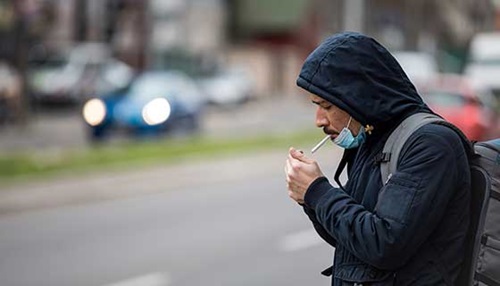
Our expert, Panagis Galiatsatos, M.D., M.H.S. discusses how smoking, vaping and air pollution might increase the severity of COVID-19. Learn about how each of these could affect a COVID-19 diagnosis.
Is COVID-19 lung damage reversible?
After a serious case of COVID-19, a patient’s lungs can recover, but not overnight. “Recovery from lung damage takes time,” Galiatsatos says. “There’s the initial injury to the lungs, followed by scarring. Over time, the tissue heals, but it can take three months to a year or more for a person’s lung function to return to pre-COVID-19 levels.
“Lung healing in of itself can produce symptoms,” Galiatsatos says. “It is similar to a leg bone breaking, needing a cast for months, and having the cast come off. No one would expect to begin to run right away with the newly-healed leg bone. As the leg strengthens and muscle re-grows, patients will experience discomfort from this healing. This is what our lungs go through, too!”
He notes that doctors and patients alike should be prepared for continuing treatment and therapy.
“Again, staying up to date with COVID-19 vaccines, including boosters is key, not only to surviving COVID-19, but potentially to ensure the scars to the lungs are not permanent. But while the lungs are healing, it is important that COVID-19 survivors touch base with physicians, who can help them recover efficiently.
“Once the pandemic is over, there will be a group of patients with new health needs: the survivors. Doctors, respiratory therapists and other health care providers will need to help these patients recover their lung function as much as possible.”

